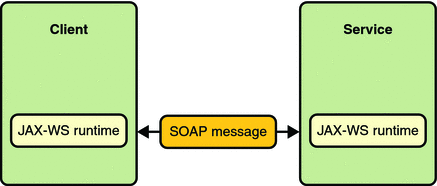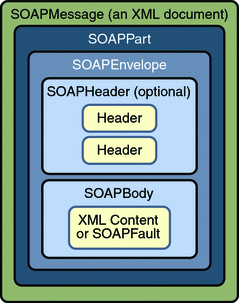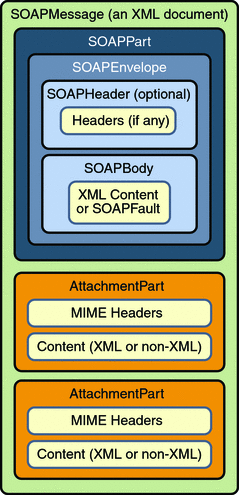
Web Service Axis :
1 import org.apache.axis.client.Call;
2 import org.apache.axis.client.Service;
3 import javax.xml.namespace.QName;
4
5 public class TestClient {
6 public static void main(String [] args) {
7 try {
8 String endpoint =
9 "http://ws.apache.org:5049/axis/services/echo";
10
11 Service service = new Service();
12 Call call = (Call) service.createCall();
13
14 call.setTargetEndpointAddress( new java.net.URL(endpoint) );
15 call.setOperationName(new QName("http://soapinterop.org/", echoString"));
16
17 String ret = (String) call.invoke( new Object[] { "Hello!" } );
18
19 System.out.println("Sent 'Hello!', got '" + ret + "'");
20 } catch (Exception e) {
21 System.err.println(e.toString());
22 }
23 }
24 }
<?xml version="1.0" encoding="UTF-8"?>
<SOAP-ENV:Envelope xmlns:xsd="http://www.w3.org/2001/XMLSchema"
xmlns:SOAP-ENV="http://schemas.xmlsoap.org/soap/envelope/"
xmlns:xsi="http://www.w3.org/2001/XMLSchema-instance">
<SOAP-ENV:Body>
<ns1:echoString xmlns:ns1="http://soapinterop.org/">
<arg0 xsi:type="xsd:string">Hello!</arg0>
</ns1:echoString>
</SOAP-ENV:Body>
</SOAP-ENV:Envelope>
Publishing web Applications :
public class Calculator {
public int add(int i1, int i2) {
return i1 + i2;
}
public int subtract(int i1, int i2) {
return i1 - i2;
}
}
% copy Calculator.java <your-webapp-root>/axis/Calculator.jws
Now for step 2... hm, wait a minute. You're done! You should now be able to access the service at the following URL (assuming your Axis web application is on port 8080):
http://localhost:8080/axis/Calculator.jws
Axis automatically locates the file, compiles the class, and converts SOAP calls correctly into Java invocations of your service class. Try it out - there's a calculator client in samples/userguide/example2/CalcClient.java, which you can use like this:
% java samples.userguide.example2.CalcClient -p8080 add 2 5
Got result : 7
% java samples.userguide.example2.CalcClient -p8080 subtract 10 9
Got result : 1
%
Web Service Deployment Descriptor (WSDD)
<deployment xmlns="http://xml.apache.org/axis/wsdd/"
xmlns:java="http://xml.apache.org/axis/wsdd/providers/java">
<service name="MyService" provider="java:RPC">
<parameter name="className" value="samples.userguide.example3.MyService"/>
<parameter name="allowedMethods" value="*"/>
</service>
</deployment>

A service endpoint interface or service endpoint implementation (SEI) is a Java interface or class, respectively, that declares the methods that a client can invoke on the service. An interface is not required when building a JAX-WS endpoint. The web service implementation class implicitly defines an SEI.
These are the basic steps for creating the web service and client:
Code the implementation class.
Compile the implementation class.
Use wsgen to generate the artifacts required to deploy the service.
Package the files into a WAR file.
Deploy the WAR file. The web service artifacts (which are used to communicate with clients) are generated by the Application Server during deployment.
Code the client class.
Use wsimport to generate and compile the web service artifacts needed to connect to the service.
Compile the client class.
Run the client.
package helloservice.endpoint;
import javax.jws.WebMethod;
import javax.jws.WebService;
@WebService
public class Hello {
private String message = new String("Hello, ");
public void Hello() {}
@WebMethod
public String sayHello(String name) {
return message + name + ".";
}
}
wsgen -cp . helloservice.endpoint.Hello -wsdl -servicename http://localhost:8080/helloservice/hello
check URL:
http://localhost:8080/helloservice/hello?WSDL
create port:
wsimport -d generated http://localhost:8080/helloservice/hello?WSDL
HelloClient is a stand-alone Java program that accesses the sayHello method of HelloService. It makes this call through a port, a local object that acts as a proxy for the remote service. The port is created at development time by the wsimport tool, which generates JAX-WS portable artifacts based on a WSDL file.
package simpleclient;
import javax.xml.ws.WebServiceRef;
import helloservice.endpoint.HelloService;
import helloservice.endpoint.Hello;
public class HelloClient {
@WebServiceRef(wsdlLocation="http://localhost:8080/helloservice/hello?wsdl")
static HelloService service;
public static void main(String[] args) {
try {
HelloClient client = new HelloClient();
client.doTest(args);
} catch(Exception e) {
e.printStackTrace();
}
}
public void doTest(String[] args) {
try {
System.out.println("Retrieving the port from the following service: " + service);
Hello port = service.getHelloPort();
System.out.println("Invoking the sayHello operation on the port.");
String name;
if (args.length > 0) {
name = args[0];
} else {
name = "No Name";
}
String response = port.sayHello(name);
System.out.println(response);
} catch(Exception e) {
e.printStackTrace();
}
}
}


The SAAJ APIs extend their counterparts in the org.w3c.dom package:
The Node interface extends the org.w3c.dom.Node interface.
The SOAPElement interface extends both the Node interface and the org.w3c.dom.Element interface.
The SOAPPart class implements the org.w3c.dom.Document interface.
The Text interface extends the org.w3c.dom.Text interface.
SAAJ Connection
SOAPConnectionFactory factory = SOAPConnectionFactory.newInstance();
SOAPConnection connection = factory.createConnection();
. . .// create a request message and give it content
java.net.URL endpoint = new URL("http://fabulous.com/gizmo/order");
SOAPMessage response = connection.call(request, endpoint);
MessageFactory factory = MessageFactory.newInstance();
SOAPMessage message = factory.createMessage();
SOAPPart soapPart = message.getSOAPPart();
SOAPEnvelope envelope = soapPart.getEnvelope();
SOAPHeader header = envelope.getHeader();
SOAPBody body = envelope.getBody();
SOAPHeader header = message.getSOAPHeader();
SOAPBody body = message.getSOAPBody();
SOAPBody body = message.getSOAPBody();
QName bodyName = new QName("http://wombat.ztrade.com", "GetLastTradePrice", "m");
SOAPBodyElement bodyElement = body.addBodyElement(bodyName);
QName name = new QName("symbol");
SOAPElement symbol = bodyElement.addChildElement(name);
symbol.addTextNode("SUNW");
The content that you have just added to your SOAPBody object will look like the following when it is sent over the wire:
<SOAP-ENV:Envelope
xmlns:SOAP-ENV="http://schemas.xmlsoap.org/soap/envelope/">
<SOAP-ENV:Body>
<m:GetLastTradePrice xmlns:m="http://wombat.ztrade.com">
<symbol>SUNW</symbol>
</m:GetLastTradePrice>
</SOAP-ENV:Body>
</SOAP-ENV:Envelope>
SOAPBody body = message.getSOAPBody();
QName bodyName =
new QName("http://sonata.fruitsgalore.com", "PurchaseLineItems", "PO");
SOAPBodyElement purchaseLineItems =
body.addBodyElement(bodyName);
QName childName = new QName("Order");
SOAPElement order = purchaseLineItems.addChildElement(childName);
childName = new QName("Product");
SOAPElement product = order.addChildElement(childName);
product.addTextNode("Apple");
childName = new QName("Price");
SOAPElement price = order.addChildElement(childName);
price.addTextNode("1.56");
childName = new QName("Order");
SOAPElement order2 = purchaseLineItems.addChildElement(childName);
childName = new QName("Product");
SOAPElement product2 = order2.addChildElement(childName);
product2.addTextNode("Peach");
childName = soapFactory.new QName("Price");
SOAPElement price2 = order2.addChildElement(childName);
price2.addTextNode("1.48");
The SAAJ code in the preceding example produces the following XML in the SOAP body:
<PO:PurchaseLineItems
xmlns:PO="http://sonata.fruitsgalore.com">
<Order>
<Product>Apple</Product>
<Price>1.56</Price>
</Order>
<Order>
<Product>Peach</Product>
<Price>1.48</Price>
</Order>
</PO:PurchaseLineItems>
SOAPConnectionFactory soapConnectionFactory =
SOAPConnectionFactory.newInstance();
SOAPConnection connection = soapConnectionFactory.createConnection();
java.net.URL endpoint = new URL("http://wombat.ztrade.com/quotes");
SOAPMessage response = connection.call(message, endpoint);
connection.close();
SOAPBody soapBody = response.getSOAPBody();
java.util.Iterator iterator = soapBody.getChildElements(bodyName);
SOAPBodyElement bodyElement = (SOAPBodyElement)iterator.next();
String lastPrice = bodyElement.getValue();
System.out.print("The last price for SUNW is ");
System.out.println(lastPrice);
If more than one element had the name bodyName, you would have to use a while loop using the Iterator.hasNext method to make sure that you got all of them.
while (iterator.hasNext()) {
SOAPBodyElement bodyElement = (SOAPBodyElement)iterator.next();
String lastPrice = bodyElement.getValue();
System.out.print("The last price for SUNW is ");
System.out.println(lastPrice);
}